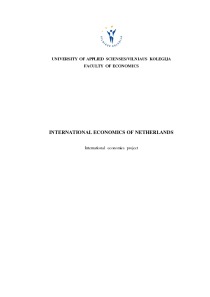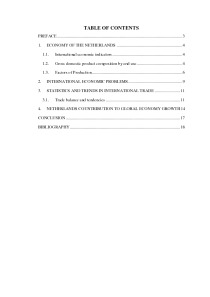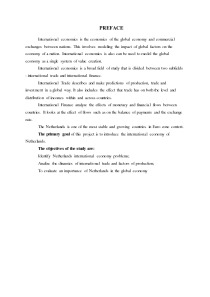Economy Of The Netherlands Paper



Preface. Economy of the netherlands. International economic indicators. Gross domestic product composition by end use. Factors of Production. International economic problems. Statistics and trends in international trade. Trade balance and tendencies. Netherlands countribution to global economy growth. Conclusion. Bibliography.
Analize the dinamics of international trade and factors of production;
To evaluate an importance of Netherlands in the global economy
The Netherlands takes the sixth place in the countries with largest economic power in Eurozone. This country also is the fifth largest exporter of products. For the past two years, the recovery in Europen Union caused gradually economy growth: an 3.1% for 2017. The International Monetary Fund predicted growth of 2.6% of GDP for 2018, which would be the fourth consecutive year with a growth above 2%. Owerall, it’s able to see that the forecast was correct: Netherlands GDP had growth of 2,67% for 2018. The Dutch presents a very high income per capita which is above the EU average and in 2017 it had reached 52,874 US dollars.
The highly mechanised agricultural sector represents around 2% of the country's GDP and employs 2% of the population. This sector produces high yields, which is due in part to the farming of arable land. About 60% of the products is exported and it makes the Netherlands the second largest exporter of agricultural products in the world. Moreover, they are also the largest flower exporter in the world.Industrial activity generates little bit less than a quarter of the GDP through food-processing, the petroleum industry, the transport equipment and metal industry. This sector employs around 15% of the workforce. This country is also one of the largest producers and distributors of oil and natural gas.Services account for over 76% of national income and employ 74% of the workforce. The services sector includes logistics, transportation, banking and insurance, water engineering and other new technologies. The Dutch carries out an important role as a European transportation channel, with Rotterdam as by far the biggest port in Europe and Amsterdam with one of the biggest airports in Europe This is not surprising as its economy largely depends upon exports.
According to statistics, the biggest part is formed by household consumption and in average it’s more or less half of The Netherlands gross domestic product. The average value for the Netherlands during period between 1970 and 2017 was 49.03 percent with a minimum of 43.91 percent in 2017 and a maximum of 53.04 percent in 1970.
According the chart of household consumption it’s able to see that over past four decades household consumption in Netherlands becoming less dominant component in whole GDP structure.
All kind of agriculture provide exports and help to maintain the country’s economy.
- Economy & Finance Papers
- Microsoft Word 194 KB
- 2019 m.
- English
- 19 pages (3563 words)
- College
- Tautvydas

















